John Petrucci: Prime Numbers

The Dream Theater shredder goes in deep with five- and seven-string groupings.
Over the last three issues we’ve focused on alternate-picking sextuplets (six-note groupings, typically phrased as 16th-note triplets), first observing the picking motion and tone on a single string, then practicing exercises and runs on two adjacent strings before building up to full six-string shapes in A Dorian (A B C D E F# G, spelled intervallically 1 2 b3 4 5 6 b7), the second mode in the key of G major. We have seen that alternate picking fluently when crossing from one string to another requires the mastery of two techniques: outside picking, so called because you’re picking the outer sides of the two strings in succession relative to one another, and inside picking, whereby you pick the inner sides of the string pair in succession. Inside picking is the more technically demanding and challenging of the two techniques because the pick has to overcome inertia and abruptly reverse direction mid-flight. It is for this reason that efficient, well-drilled technique is a must for achieving alternate-picking speed and fluidity.
Working with sextuplets, we have become accustomed to accenting the first note of each beat (the downbeat) with a downstroke. This is the case when alternate picking any rhythmic subdivision that contains an even number of notes per beat (such as eighth notes, 16ths and 32nds), and by striking the string harder and accenting the downstroke on the beat, we can help maintain good accurate synchronization between the two hands.
This month we will form a new routine that will help develop odd note groupings of five and seven while bolstering your inside-picking technique. We are still in 4/4 time, but each beat will now be divided into odd subdivisions of either five or seven evenly spaced notes, known, respectively, as quintuplets and septuplets. Since we are now dealing with an odd number of notes per beat and an even number of alternating pick strokes (two), the first beat will start, as usual, on a downstroke, but the second beat will be accented with an upstroke, and you will thereafter alternate your accents from a downstroke to an upstroke on every subsequent downbeat.
This month’s lesson plan follows our established practice strategy of initially developing new patterns and motions on a single string, then expanding to cover two strings, wherein we can observe the outside and inside picking movements, and finally building to six-string scale shapes. Playing odd note groupings at high speeds creates a rolling, shred-like sound and is common in the style of modern rock virtuosos.
As most of us are more accustomed to playing and hearing runs that comprise even-numbered groupings of four or six notes, these quintuplets and septuplets may take some getting used to. I encourage you to practice each example without a metronome for the first 10 minutes or so to establish the pattern in your hands and ears; then, start off very slowly with the metronome while tapping your foot along with it. You may find it helpful to count quintuplets as “one two three four five,” with an emphasis on “one,” and septuplets as “one two three four five six sev,” lopping off the “en” from “seven” to make it a one-syllable word.
In the audio demonstrations for the examples included on this month’s CD-ROM, the quintuplet exercises are initially played at a slow “learn” speed of 60 beats per minute, followed by a top standard speed of 150 bpm. The septuplets, being “faster,” are learned at 50 bpm, with 120 bpm as the top standard speed.
You should aim to fully master these slower tempos before gradually increasing speed, which will be the byproduct of consistent practice and solid time keeping. As always, it is pointless to increase speed before you can play something cleanly, smoothly and in time. Once you have done a week of practice, the feel of these odd groupings will start to set in, and the foundation will then be set for technique development.
As previously, any examples that feature vibrato “exit” or finishing notes are musical phrases, as opposed to static repetition exercises, and should be played with wide, hearty rock vibrato. Vibratos and bends on the first or second strings should be pushed upward and on the lower strings pulled downward. There are normally three vibrato cycles, or pulses, before trailing off the string. This punctuating element is the finishing touch in presenting the phrases with an authentic modern rock nuance and is as important as the run itself, so always be aware of the importance of a well-played finishing note.

FIGURE 1—FOUNDATION EXERCISE
Our first example is a single-string repetition fragment that has you shifting positions from fifth to seventh to eighth and back. This exercise will be the first step in getting you comfortable with the concept of accenting the beat, first on a downstroke and then, on beat two, on an upstroke. All subsequent examples build from this initial pattern, so take care to accent the beat, and try to internalize the feel of the quintuplet. Listen carefully to the audio demonstration, and do not increase speed until the motion of the pick and the feel of the exercise starts to solidify. Use the tip of the pick with a fairly wide swing of around two centimeters either side of the string to ensure a good, even tone, contracting the movement as you increase the tempo.

FIGURE 2—INSIDE PICKING
Here we have a static repetition fragment that incorporates two strings and inside picking on each cross. The control and synchronization will come from a firm accented note on each downbeat. Try to concentrate on the downstroke accents on beats one and three. Use the time spent between string crosses to relax, recuperate and prepare for the next cross.

FIGURE 3—OUTSIDE PICKING
As the counterpart to the previous example, here’s a similar pattern that exclusively uses outside picking, otherwise known as “hooking around.” Swing the pick widely at first at the slower tempos and aim for the very tip of the pick for an even velocity, apart from the accented downbeats, which should be played slightly louder than the other notes, as this will aid in synchronizing the two hands.

FIGURE 4—TWO-STRING REPETITION FRAGMENT
This exercise incorporates two sets of quintuplets per string, shifting through three symmetrical positions of A Dorian, starting in fifth position. As you move from beat four of bar 1 to the downbeat of bar 2, try to shift your frethand position by reaching and expanding your finger spread rather than by an abrupt shift alone. Again, accent each beat with the pick, using a downstroke on beats one and three of each bar and an upstroke on beats two and four.

FIGURE 5—THREE-STRING QUINTUPLET RUN
Here we have a series of quintuplets played across the top three strings, on which the fret hand alternately leads off with the fourth and first fingers. For the pick hand, this pattern offers an excellent way to practice shifting from inside to outside picking. The first string cross, from the high E to the B, requires the inside technique, and the move from the B to the G string utilizes outside picking. Try doing the same kind of pattern on different sets of strings, and remember to keep focused on accenting the downstrokes and upstrokes that fall on the beats.

FIGURE 6—SIX-STRING RUN
Aim to keep the run at an even velocity of tone by swinging the pick wide over each string, with contact right on its tip. Accent the first note on each string, noting the downstrokes on beats one and three and upstrokes on beats two and four. Be sure to apply a wide “pull-down” vibrato to the finishing note. Use the wrist, pivoting from the sharply angled index-finger-and-thumb clamp, and pull the string downward using wrist rotation, the fingers themselves remaining rigid.

FIGURE 7—ASCENDING VERSION OF PREVIOUS RUN
Applying the pattern from the previous example in the opposite direction—starting on the low E string—this run finishes with a half-step bend on the high E, which is then adorned with vibrato. Think of the vibrato as being applied once the bend has relaxed back to its starting pitch, rather than from the apex of the bend, as the vibrato should not go above that pitch. Three pulses is the standard for rock vibrato and makes for an authentic and dramatic exit to these ideas.

FIGURE 8—POSITION SHIFTING ACROSS STRINGS
This horizontal stacking of two shapes per string opens up the potential for serious speed, as the mind and right hand can focus on uninterrupted picking without crossing strings for longer durations. This approach also helps us move through positions and extend the range of our runs. Once you memorize this, try to design your own runs, moving in different distances across the neck. As you spend more time creating runs and transcribing those of the great players, you’ll see improvements in your ability to visualize the scale and navigate the neck.
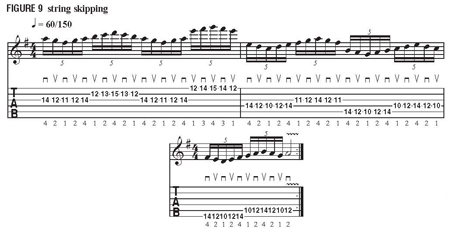
FIGURE 9—STRING SKIPPING
Here’s a string-skipping example in the style of John Petrucci. You may want to break it down into sub-exercises at first and master each subsequent beat and string cross separately before tying the whole thing together. Use the wrist when picking over two strings, and notice that, in order to maintain the same pick angle relative to each string, you will use the arm as a boom to maneuver the wrist over the strings being picked. This will come from the elbow, but it is in no way associated with any tension.
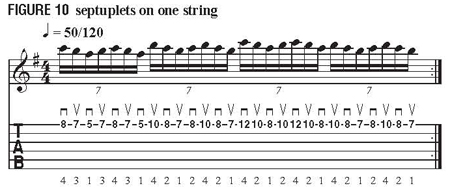
FIGURE 10—SEPTUPLETS ON ONE STRING
This next example introduces septuplets. As with all the quintuplet examples, beats one and three are always picked with a downstroke accent, and beats two and four are always accented with an upstroke. The septuplet is a full roll and leads from the fret-hand pinkie on every beat. As you play through the example slowly, try to lock in the foot tapping with the downbeats and pick accents.
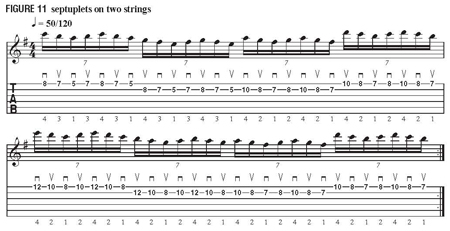
FIGURE 11—SEPTUPLETS ON TWO STRINGS
For this example, pick lightly and evenly, swinging the pick across the string with plenty of wrist momentum. Use the very tip of the pick with a slight downward angle to get an even velocity as you play through. Keep your foot tapping on the beat, and concentrate on the alternating downstroke and upstroke accents.
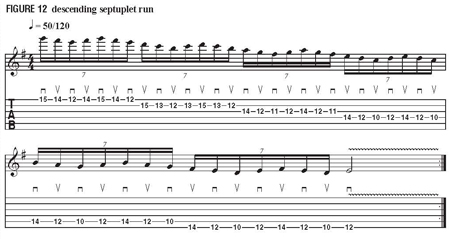
FIGURE 12—DESCENDING SEPTUPLET RUN
Here we have a descending septuplet run across all six strings, finishing with a wide “pull-down” rock vibrato on the low E at the 12th fret. Try to ensure that, on the fretting hand, you are aware of the index finger muting the string above the one you are currently playing by stubbing the flesh of the tip of the finger into the string above. The index finger should also lightly lay across any strings underneath the one being picked in order to mute them and suppress unwanted string noise.
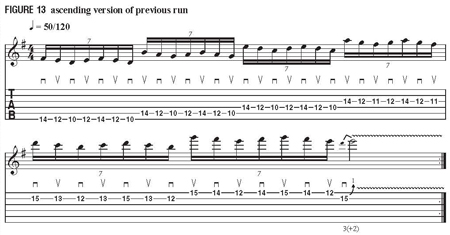
FIGURE 13—ASCENDING VERSION OF PREVIOUS RUN
This is the upward counterpart to our previous example. The finishing note is struck with a downstroke and adorned with a wide vibrato. Pick the run as evenly as possible, accenting the downbeats with the pick and reinforcing the feel by tapping the foot.

FIGURE 14—16TH NOTES IN GROUPS OF SEVEN
Seven-note groupings don’t necessarily have to be played as septuplets. An interesting rhythmic-melodic effect can be achieved by phrasing 16th notes in groups of seven, as demonstrated in this example. You can hear this kind of idea often in John Petrucci’s playing. It’s a great device to employ for the sake of generating interestingly unusual melodic contours and syncopations within an unbroken stream of 16th notes.

FIGURE 15—MORE SEVEN-NOTE GROUPINGS
Our final example takes this concept a step further and implies odd note groupings of five and seven within a steady stream of 16th notes. Applying this approach will help you develop a fresh vocabulary of 16th-note melodic phrases inspired by patterns that you initially learned with triplets, quintuplets or septuplets, so experiment! You can start by taking any of the previous examples in this lesson and changing the rhythm to eighth-note triplets, 16th notes or 16th-note triplets.
Get The Pick Newsletter
All the latest guitar news, interviews, lessons, reviews, deals and more, direct to your inbox!
“There are so many sounds to be discovered when you get away from using a pick”: Jared James Nichols shows you how to add “snap, crackle and pop” to your playing with banjo rolls and string snaps
Don't let chord inversions bamboozle you. It's simply the case of shuffling the notes around







![Joe Bonamassa [left] wears a deep blue suit and polka-dotted shirt and plays his green refin Strat; the late Irish blues legend Rory Gallagher [right] screams and inflicts some punishment on his heavily worn number one Stratocaster.](https://cdn.mos.cms.futurecdn.net/cw28h7UBcTVfTLs7p7eiLe.jpg)


